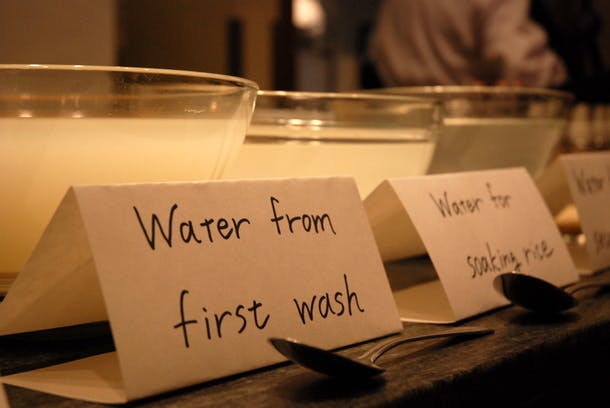
how to cook rice, or the essence of japanese cuisine
Preparing rice the traditional Japanese way is a reflection of _ajiwai_, the essence of Japanese cuisine. This article outlines the detailed steps and techniques provided by master chef Yoshio Maruyama for making perfect Japanese rice, including the special equipment, washing and soaking, polishing, resting, and cooking processes.
Preparing rice in Japan is well, more than just preparing rice. Cooking this grain the traditional way reflects a sense of ajiwai, the ability to get the most out of the natural flavor of a particular ingredient - the essence of Japanese cuisine.
At the recent Japanese food forum here in New York, master chef Yoshio Maruyama of Kyoto demonstrated this sensibility by walking the audience through the classic technique for making rice. Through this method, he explained, "we bring alive the real flavor and integrity of the ingredient. This is the heart of Japanese cooking."
Here are my notes from the lecture, including Chef Maruyama's steps for preparing rice. I'd be grateful if add your thoughts in the comments section! I know that different chefs have different approaches to making Japanese rice, plus there are regional differences to consider, too.
Ingredients & Equipment
Rice, of course. Japan grows about 300 varieties, mostly short grain. Water, which is purified by immersing all-natural Japanese bincho oak charcoal for ten hours. The bincho (ratio of 10:1 of water to bincho, by weight) returns water to its natural state. The chef used this purified water for all washing, soaking and cooking. Back home in Kyoto he draws spring water from his own well, but feels that tap water is fine (bottled mineral water is not necessary). A traditional rice cooking pot has a flange and a specific curvature that allows steam to flow in a circular motion while the rice cooks. The cover is made from wood (cedar or cypress), which absorbs excess moisture.
"First Wash" & Soak
The chef washed the rice in a bowl of water to remove dust and surface starch by gently swirling the rice and very quickly draining the water, which took on the color and consistency of milk. He then refilled the bowl with water and let the rice soak for 30 minutes. Why? "Rice is a seed," he explained. "When it soaks it absorbs water and comes back to life." The rice will simulate "germination" during this soaking time. (If you didn't soak, by the way, the rice grain would crack when you cook it).
How do you know when the rice has soaked long enough? Place a grain of rice between your thumb and index finger and squeeze. When the rice has soaked fully, the grain will compress rather than fly off your thumb.
Polishing & Subsequent Washes
Once the rice finished soaking, the Chef drained it and added fresh water in the bowl, to "polish" the rice to remove surface bran. You have to remove the bran for rice to become perfectly white. With one hand, the Chef made a kneading motion in the bowl as he worked, like he was kneading bread dough. He then quickly drained the milky colored water. He refilled the bowl and repeated this process three more times. You must polish and drain three or four times until the water becomes clear (doesn't have to be crystal clear). Remember, too, to be gentle with your rice -- the first knead is vigorous, but the subsequent ones are gentle. You don't want to break the grains.
Resting the Rice
Once the Chef finish polishing, he drained the rice into a strainer (that will let water drip out), covered with a cheesecloth and let it rest for 20 minutes. This is a natural drying process to remove excess water. The result is that each grain of rice contains just the right amount of moisture it needs -- this natural humidity is what allows heat to uniformly transfer through the material when you cook it.
Cooking the Rice
Now the Chef was ready to cook the rice in a traditional rice pot (His was a special clear glass number fabricated especially for demonstrations). He added the rice and water, the proportion being one to one by weight (not by volume). He covered with the wooden cover (if you're cooking a lot of rice you'll want to rest a stone on top to weigh the cover down) and cooked over high heat until the rice and water started boiling -- you'll know because steam will start escaping from under the lid. Important: You have to time this first cooking step, from start to boil.
Next, he reduced heat to medium and continued cooking for the exact amount of time of that first cooking step. The chef turned off the heat, and rested the rice for ten to fifteen more minutes (it will finish cooking while resting). One note: Don't fill the cooking pot above the flange -- the air space between the flange and the cover is necessary for the right amount of pressure to build up and for the steam to circulate.
Eat the Rice
Once it was ready, the chef passed spoonfuls of rice to the audience. It was remarkable. The rice smelled beautiful, and had a delicate, sublime taste. It reminded me of how much the flavor of simple, plain rice struck me when I first traveled to Japan. Until then, rice, to me, was an afterthought. Something to soak up sauce. That all changed when I tasted Japanese rice at the source, freshly harvested and cooked traditionally. I understood what the Chef meant when he said it was the essence of the cuisine, and why he dedicated his lecture - the forum's keynote address, no less -- to this humble food.
